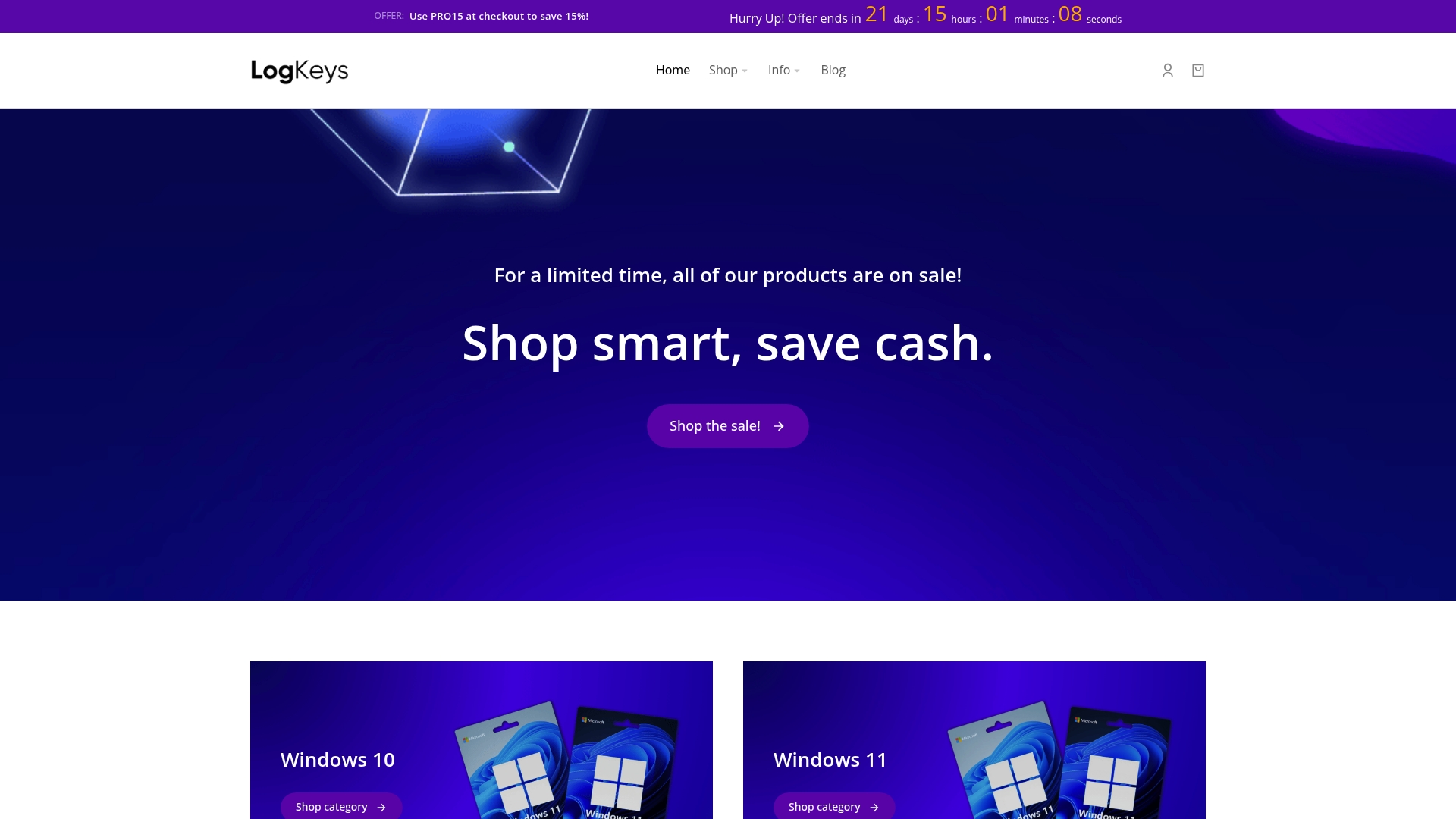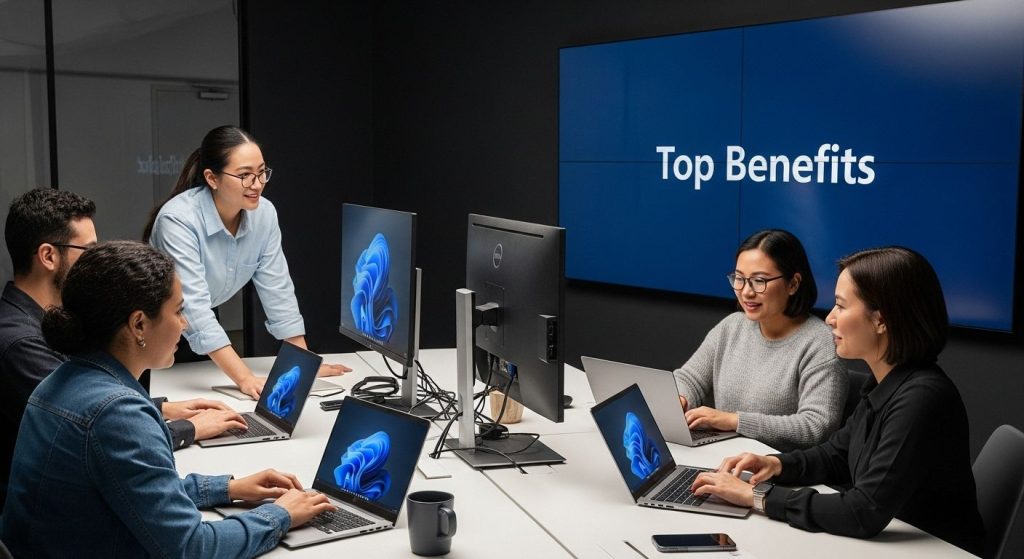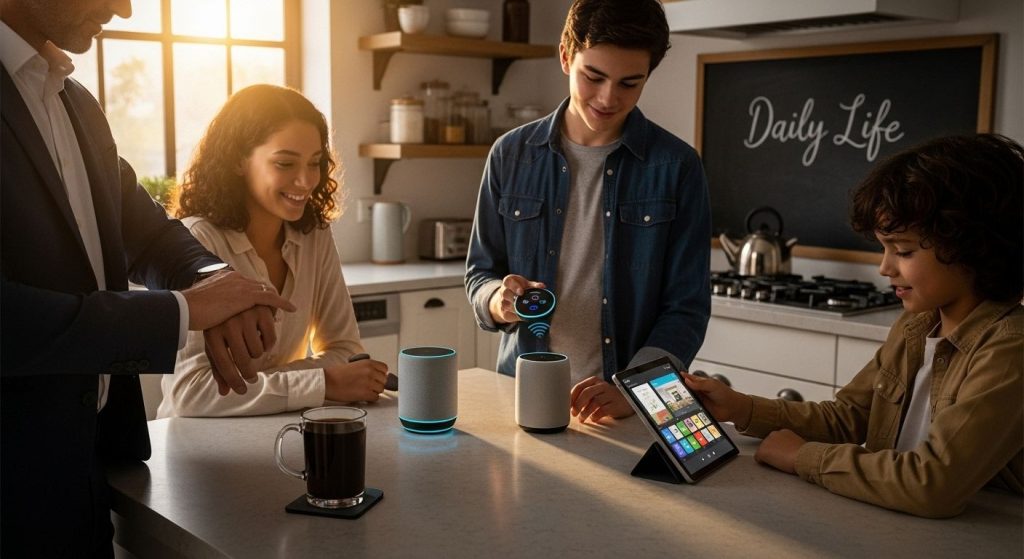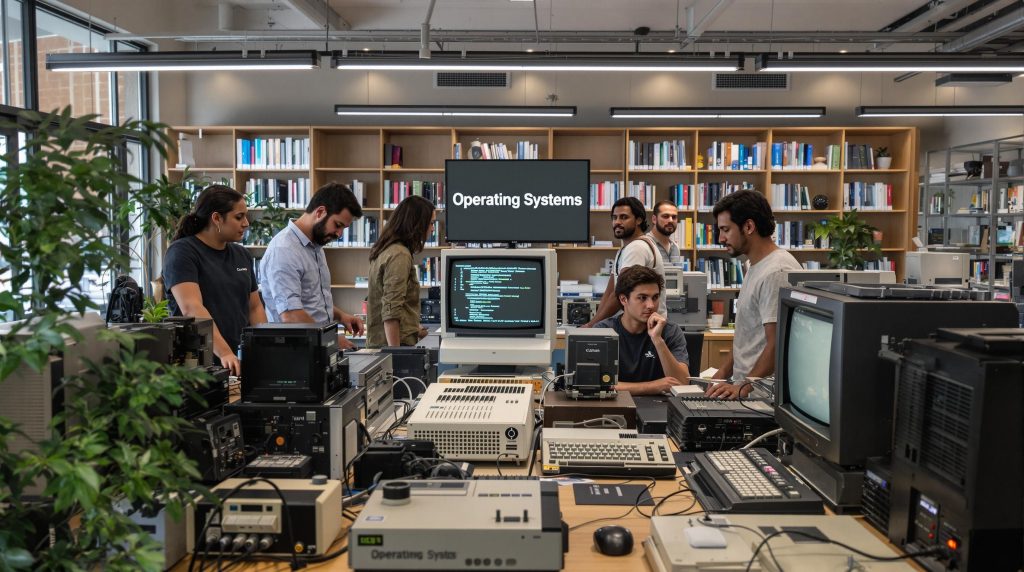Everyone keeps talking about difference between windows 10 and 11 and how it looks fresh, sleek, and modern. You might have seen headlines about a visually redesigned interface and new multitasking tricks. Yet, most people overlook the fact that Windows 11 update packages are about 40 percent smaller than those in Windows 10, making installs and updates much faster. This quiet improvement could totally change how you manage your computer, especially if speed and convenience matter to you.
Table of Contents
ToggleQuick Summary
| Takeaway | Explanation |
|---|---|
| Windows 11 Features Centered Start Menu | The new centered Start menu enhances user experience by improving visual ergonomics and reducing unnecessary mouse movement. |
| Significant Performance Optimizations | Windows 11 offers faster login times, web browsing, and smaller update packages, though it may consume more memory. |
| Advanced Multitasking Tools Available | Features like Snap Layouts and Virtual Desktops streamline multitasking and improve workflow efficiency for users. |
| Strict Minimum System Requirements | Users need to ensure devices meet Windows 11’s minimum specifications to avoid performance issues and security risks. |
| Integrated Microsoft Teams for Collaboration | The inclusion of Microsoft Teams in the taskbar allows for seamless communication and enhanced remote collaboration directly from the OS. |
Visual and Design Changes in Windows 11
Windows 11 marks a significant visual transformation from its predecessor, reimagining the user interface with a modern and streamlined approach. The design overhaul goes beyond mere aesthetic changes, introducing a more intuitive and visually appealing computing experience that reflects contemporary design principles.
Centered Start Menu and Taskbar
One of the most striking visual differences in Windows 11 is the centered Start menu and taskbar icons. Unlike Windows 10’s traditional left-aligned layout, Windows 11 adopts a Mac-like centered design that immediately creates a sense of balance and symmetry. Explore our guide on Windows 11 upgrades to understand how this design shift impacts user interaction.
According to The Verge, this centered approach is not just a cosmetic change but a deliberate strategy to improve visual ergonomics. The new layout reduces eye and mouse movement, potentially enhancing user efficiency and comfort during extended computing sessions.
Refined Aesthetics and Fluent Design
Windows 11 introduces a significant update to Microsoft’s Fluent Design System, focusing on simplicity, clarity, and modern aesthetics. The interface now features rounded corners for windows, a softer color palette, and more translucent elements that create a sense of depth and sophistication.
Research from TechTarget highlights key visual transformations:
- Rounded Window Geometry: Sharp edges are replaced with smooth, rounded corners, giving applications a more contemporary and less rigid appearance.
- Simplified Start Menu: Live tiles from Windows 10 have been eliminated, replaced by a clean grid of pinned apps and a cloud-powered ‘Recommended’ section.
- Updated Iconography: The system-wide icons have been redesigned to appear more consistent, minimalist, and aligned with modern design trends.
Enhanced Window Management
Beyond pure aesthetics, Windows 11 introduces Snap Layouts, a feature that dramatically improves window management. Users can now easily organize multiple windows with intuitive, preset grid arrangements. This design change reflects a user-centric approach, recognizing the growing need for efficient multitasking in modern work environments.
The visual evolution in Windows 11 is not just about looking different but about creating a more engaging, efficient, and user-friendly computing environment. Each design choice seems carefully considered to balance aesthetic appeal with functional improvements, setting a new standard for operating system interfaces.
Whether you’re a design enthusiast or a productivity-focused user, Windows 11’s Home edition offers a refreshed visual experience that combines form and function in a compelling package.
Performance and Speed Comparisons
Comparing the performance and speed between Windows 10 and Windows 11 reveals nuanced differences that can significantly impact user experience. While both operating systems share fundamental similarities, Windows 11 introduces several technological enhancements that subtly influence system performance.
CPU and Memory Resource Management
Windows 11 demonstrates notable changes in resource allocation and management. Research from GO-EUC indicates that Windows 11 consumes approximately 13% more memory compared to its predecessor. This increased memory footprint stems from additional background services and enhanced visual effects designed to improve overall system responsiveness.
The performance implications are particularly significant for systems with limited hardware resources. Users with older or less powerful computers might experience slight performance reductions, especially during multitasking scenarios. Explore our guide on Windows 11 hardware requirements to understand compatibility and potential performance considerations.
Benchmark and Performance Metrics
According to TechSpot’s comprehensive analysis, Windows 11 and Windows 10 demonstrate remarkably similar performance across various benchmark tests. However, critical differences emerge when Virtualization-Based Security (VBS) is activated:
- Single-Core Tasks: Performance reduction of approximately 5%
- File Compression: Potential performance decrease up to 10%
- Background Services: Increased CPU utilization compared to Windows 10
These performance variations underscore the importance of understanding your specific hardware configuration and workload requirements before upgrading.
System Optimization and Responsiveness
TechTarget’s research highlights several performance improvements in Windows 11 that enhance overall system responsiveness:
- Faster Logins: Windows Hello authentication provides quicker access
- Web Browsing: Improved browser performance and efficiency
- Wake from Sleep: Reduced system resumption time
- Update Optimization: Update packages are approximately 40% smaller, reducing download and installation duration
These incremental improvements contribute to a more streamlined user experience, though the actual impact varies depending on individual system configurations.
Ultimately, the performance difference between Windows 10 and Windows 11 is nuanced. While Windows 11 introduces technological advancements, the practical performance gain might be minimal for average users. Discover our Windows 11 Home edition to determine whether the upgrade aligns with your specific computing needs.

To help readers easily compare performance differences between Windows 10 and Windows 11, especially regarding statistics and resource usage, the table below summarizes key metrics from the section above.
| Metric / Feature | Windows 10 | Windows 11 |
|---|---|---|
| Average Memory Usage | Standard baseline | ~13% higher |
| Update Package Size | 100% (reference) | ~60% (about 40% smaller) |
| Virtualization-Based Security | Optional, minor impact | Active, can slow perf. |
| Single-Core Perf. (VBS On) | Baseline | ~5% reduction |
| File Compression (VBS On) | Baseline | Up to 10% slower |
| Wake from Sleep | Standard | Faster |
| Login & Authentication | Standard | Faster (Windows Hello) |
New Features and Productivity Tools
Windows 11 introduces a comprehensive suite of productivity tools and features that significantly distinguish it from Windows 10, focusing on enhanced workflow efficiency and user experience. These innovations transform how users interact with their computers, offering more intuitive and streamlined computing environments.
Advanced Window Management and Multitasking
Microsoft’s productivity features highlight Windows 11’s revolutionary Snap Layouts and Snap Groups, which represent a quantum leap in window management. Unlike Windows 10’s basic window positioning, Windows 11 allows users to rapidly organize multiple application windows into predefined grid layouts with unprecedented ease.
Virtual desktops receive a substantial upgrade in Windows 11, enabling users to create and manage multiple desktop environments more efficiently. This feature proves especially valuable for professionals who need to segregate work tasks, personal projects, and entertainment spaces. Discover advanced productivity techniques to maximize these organizational capabilities.
Integrated Communication and Collaboration
TechTarget’s research reveals that Windows 11 integrates Microsoft Teams directly into the taskbar, eliminating the need for separate application downloads. This seamless communication tool represents a significant productivity enhancement, allowing instant messaging, video calls, and collaborative work directly from the operating system.
The integrated communication ecosystem extends beyond Teams, with improved sharing capabilities and more intuitive cross-application interactions. Windows 11 simplifies file sharing, screen sharing, and collaborative workflows, making remote work and team collaboration more accessible than ever before.
Enhanced Productivity Widgets and Personalization
Oxford University’s IT research highlights Windows 11’s redesigned widgets panel, which provides personalized information streams directly on the desktop. Unlike Windows 10’s static live tiles, these widgets offer dynamic, real-time updates for news, weather, calendar events, and productivity metrics.
The widgets can be customized to display information most relevant to individual users, transforming the desktop into a personalized productivity dashboard. Machine learning algorithms adapt these widgets over time, creating increasingly tailored information experiences that help users stay informed and focused.
While Windows 11 introduces numerous productivity enhancements, the true value lies in how these features integrate to create a more intuitive computing experience. Explore Windows 11’s Home edition to unlock these powerful productivity tools and reimagine your digital workflow.
The transition from Windows 10 to Windows 11 is not just an upgrade but a fundamental reimagining of how users interact with their computers, emphasizing efficiency, personalization, and seamless connectivity.
To clearly see how Windows 11 productivity features evolve compared to Windows 10, the following table organizes new and improved tools mentioned in this section.
| Feature | Windows 10 | Windows 11 |
|---|---|---|
| Snap Layouts/Snap Groups | Basic Snap (2 windows) | Advanced grid layouts, Snap Groups |
| Virtual Desktops | Supported, basic controls | Multiple desktops, easier switching |
| Widgets/Live Tiles | Live Tiles in Start Menu | Widgets panel, customizable, AI-powered |
| Teams Integration | Separate app, not built-in | Taskbar integrated, seamless comms |
| File & Screen Sharing | Standard options | Simplified, cross-app collaboration |
Device Compatibility and Upgrade Options
Navigating the transition from Windows 10 to Windows 11 requires a comprehensive understanding of device compatibility and upgrade pathways. As technology evolves, not all existing devices will seamlessly support the latest operating system, making it crucial to assess your hardware’s readiness.
Minimum System Requirements
Microsoft’s official documentation outlines stringent hardware specifications for Windows 11 compatibility. Unlike previous Windows versions, Windows 11 introduces more demanding requirements that significantly narrow the range of eligible devices:
- Processor: 1 GHz with 2 or more cores
- RAM: Minimum 4 GB
- Storage: At least 64 GB
- System Firmware: UEFI with Secure Boot capability
- Security Chip: Trusted Platform Module (TPM) version 2.0
- Graphics: DirectX 12 compatible graphics card
Check your upgrade pathway to determine whether your current hardware meets these specifications. Devices purchased before 2019 might face significant challenges in meeting these requirements.
Upgrade Strategies and Considerations
The University of North Carolina at Greensboro emphasizes the critical timeline for Windows 10 users. With Windows 10 support ending in October 2025, users must proactively plan their upgrade strategy. Devices manufactured since 2019 are more likely to be compatible, while older machines may require hardware replacement.
Microsoft recommends against installing Windows 11 on devices that do not meet minimum requirements. Unsupported installations may result in:
- Limited Update Access: No security patches or feature updates
- Performance Instability: Potential system crashes or slowdowns
- Security Vulnerabilities: Increased risk of potential exploits
Navigating Compatibility Challenges
Microsoft’s support documentation provides clear guidance for users facing compatibility obstacles. For devices falling short of requirements, users have several options:
- Hardware Upgrade: Replace existing components to meet Windows 11 specifications
- Continue with Windows 10: Maintain current system until October 2025
- Selective Upgrade: Upgrade only compatible devices in your ecosystem
Before making a decision, carefully evaluate your specific computing needs, budget constraints, and long-term technology strategy. Explore our Windows 11 Home edition to understand the full range of upgrade possibilities and ensure a smooth transition to the latest operating system.
The path to Windows 11 is not universal. Each user’s journey will depend on their unique hardware configuration, budget, and technological requirements. Careful planning and informed decision-making are key to a successful upgrade experience.

Frequently Asked Questions
What are the main visual differences between Windows 10 and Windows 11?
Windows 11 features a centered Start menu and taskbar, refined aesthetics with rounded corners, and enhanced window management tools like Snap Layouts, giving it a more modern and balanced look compared to Windows 10.
How does the performance of Windows 11 compare to Windows 10?
Windows 11 offers significant performance optimizations, including faster login times and smaller update packages, but it may consume approximately 13% more memory. Users may notice improved responsiveness, especially with modern hardware.
What new features does Windows 11 introduce to enhance productivity?
Windows 11 introduces advanced multitasking tools like Snap Layouts and Snap Groups, integrates Microsoft Teams directly into the taskbar for seamless communication, and offers a customizable widgets panel that provides personalized information streams.
What are the minimum system requirements to upgrade to Windows 11?
To upgrade to Windows 11, devices must meet the following minimum specifications: a 1 GHz processor with 2 or more cores, a minimum of 4 GB of RAM, at least 64 GB of storage, UEFI firmware with Secure Boot capability, a TPM version 2.0, and a DirectX 12 compatible graphics card.
Upgrade With Confidence: Genuine Windows Keys For A Seamless Transition
Are you worried about meeting strict Windows 11 requirements or losing performance after upgrading? This article highlighted real challenges like device compatibility, memory usage, and the end of support for Windows 10. Whether you need a smooth activation for your new system or want to stay secure until you can upgrade, your next step matters. Logkeys.com is here to help you avoid frustrating errors, downtime, and security risks with fast, affordable genuine licenses for Windows 10 and Windows 11.

Take control of your upgrade. Shop genuine Windows product keys for instant, secure activation. Move forward with confidence today and experience 24/7 expert support at every step. Visit Logkeys.com for the solutions you need to make your Windows transition easy and worry-free.
Recommended
- How to Upgrade Windows 7 to Windows 11 in 2025 Easily – LogKeys
- Windows 11 Home Key: Everything You Need to Know About Activation, Licensing, and Buying Safely – LogKeys
- Windows 10 For PC Install & Download Windows 10 For PC – LogKeys
- Windows 10 For PC Install & Download Windows 10 For PC – LogKeys
- Web Development Basics 2025: Guide for Modern Businesses
- Should you upgrade to Windows 10 | TECHTRON











